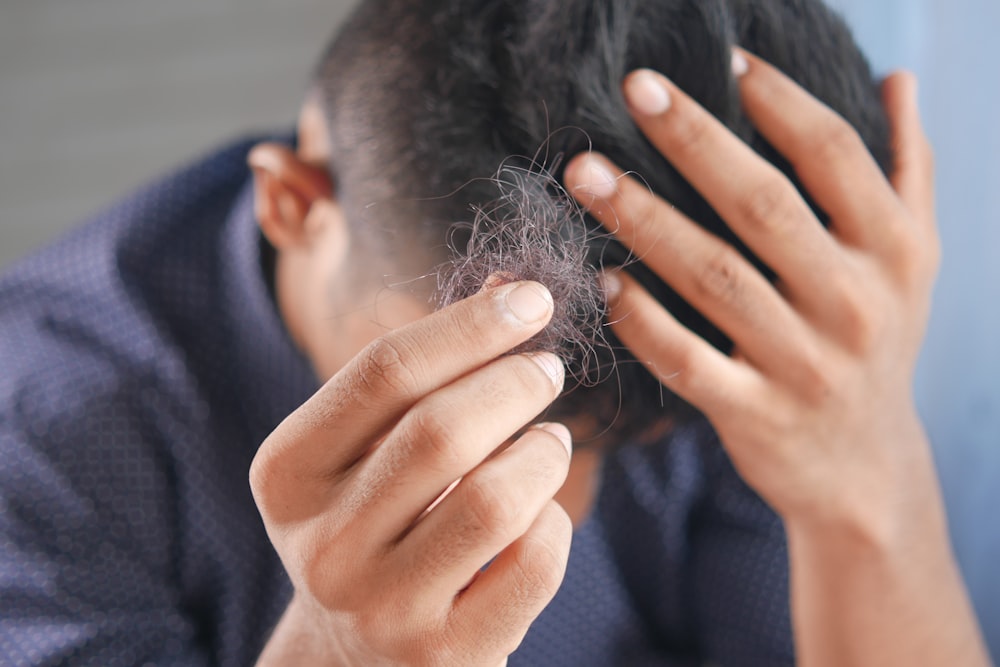Hair loss or alopecia, is a universal concern that echoes in countless households. It's a real-life problem that affects self-esteem and confidence. Different things can contribute to this common problem. One big factor is family history – the way our relatives' hair behaves can affect ours too. Things in the world around us, like pollution and not-so-healthy lifestyles, can also make our hair fall out. It's important to understand these everyday reasons for hair loss as we look into possible solutions, like the one we'll talk about in this post – Pyrilutamide.
Hormones, which are chemicals in our bodies, also play a role, especially during important times like growing up, having a baby, or reaching a certain age. Today we will cover various factors—genetics, hormones, and environmental triggers—reasons for hair loss. So keep reading to learn more!

What is Pyrilutamide?
As a potential treatment for androgenetic alopecia, pirilutamide, a topical androgen antagonist, is currently being studied. Even though it's not a famous thing, it's part of a group of substances that scientists find interesting for different uses. Pyrilutamide doesn't have a long history like some famous things, but scientists are starting to pay attention to it. It was invented and commercialized by Kintor Pharmaceutical Limited, a company known for developing innovative treatments for androgen receptor-related diseases.
What is Androgenic Alopecia?
Androgenic alopecia, affecting roughly 50% of men and 30% of women worldwide, stands as the predominant form of hair loss. This prevalent condition arises from a hormonal imbalance that leads to the shrinkage of hair follicles, resulting in gradual hair thinning and eventual loss.
It is a hormonal imbalance that specifically impacts the hair follicles. This imbalance causes them to shrink, leading to the thinning of hair strands and, eventually, hair loss. Genetic predisposition plays a significant role in the development of androgenic alopecia, with specific genes making individuals more susceptible to this condition.
Treatment Approaches
Several treatment options are available for managing androgenic alopecia:
Medications: 5-alpha reductase inhibitors and oral minoxidil are commonly prescribed medications that work to address hormonal imbalances and promote hair regrowth.
Innovative Therapies: Platelet-rich plasma (PRP) is an effective treatment that stimulates hair growth by utilizing the body's healing properties. Low-level laser therapy (LLLT) devices have also shown promise in encouraging hair regrowth through non-invasive means.
Properties of Pyrilutamide
Pyrilutamide, scientifically identified as 4'-cyano-3'-trifluoromethyl-biphenyl-4-carboxylic acid, possesses a complex molecular structure. Comprising a biphenyl core with a cyano group at the 4' position and a trifluoromethyl group at the 3' position, Pyrilutamide's structural intricacies contribute significantly to its pharmacological behavior.
The biphenyl core imparts stability and rigidity to the molecule, while the presence of a cyano group enhances its reactivity. Additionally, the trifluoromethyl group influences the compound's lipophilicity which affects its absorption and distribution within the body.
Mechanism of Action
Pyrilutamide's role in mitigating hair loss revolves around its function as an antiandrogen. This involves a competitive interaction with endogenous androgens, such as testosterone and dihydrotestosterone, at androgen receptors. By impeding this interaction, Pyrilutamide disrupts the androgen signalling pathway.
Distinctive Attributes for Hair Loss
Targeted Modulation
Pyrilutamide's ability to selectively modulate androgen receptors associated with hair loss contributes to its potential as an intervention. This selectivity enhances its utility while minimizing the likelihood of unintended systemic effects.
Dual Modulatory Action
A notable feature of Pyrilutamide lies in its dual action—acting both as a competitive androgen receptor antagonist and an inhibitor of androgen synthesis. This dual modulatory capacity positions Pyrilutamide as a versatile candidate for addressing diverse aspects of hair loss.
Expanded Applications
While recognized for its role in prostate-related conditions, Pyrilutamide extends its utility to encompass concerns related to hair growth and loss. This expansion in applications underscores its versatility in the realm of dermatology.
Real-Life Reasons for Hair Loss
Hair loss is a complex phenomenon with various types. The factors contributing to hair loss range from genetics and hormonal imbalances to medical conditions, medications, and lifestyle choices.
Some Common Hair Loss Causes:
Genetics: Hereditary factors play a significant role, with certain genes predisposing individuals to hair loss conditions.
For instance, if your dad's hair started thinning in his thirties, there's a possibility you could experience a similar pattern.
Hormonal Imbalances: Fluctuations in hormones can lead to hair loss, especially conditions like androgenic alopecia. During significant life events like puberty, pregnancy, or menopause, hormonal changes can influence the delicate balance of hair growth and loss.
A real-life example is postpartum hair loss, where new mothers may notice increased shedding due to hormonal fluctuations after giving birth.
Medical Conditions: Underlying health issues, such as autoimmune diseases and thyroid disorders, can contribute to hair loss.
Medications: Certain drugs, including those for cancer, arthritis, and depression, may have hair loss as a side effect.
Lifestyle Factors: Stress, poor nutrition, and inadequate hair care practices can contribute to hair loss. External factors like pollution, stressful lifestyles, and exposure to harmful substances can act as triggers for hair loss.
For instance, individuals living in urban areas with high pollution levels might experience more challenges in maintaining healthy hair compared to those in cleaner environments.
Pyrilutamide and Hair Loss
Pyrilutamide is thought to help with hair loss because it has a property called "antiandrogenic," meaning it interferes with certain hormones known as androgens which can contribute to hair loss. Pyrilutamide works by disrupting the signaling pathway of these hormones to prevent hair thinning and loss.
Some preliminary findings suggest a potential impact of Pyrilutamide on hair loss, particularly in conditions influenced by androgens.
Differentiating Established Facts and Ongoing Research:
Established Facts:
- Pyrilutamide is recognized for its antiandrogenic properties.
- It has been studied in the context of treating conditions like prostate cancer.
Ongoing Research and Speculation:
- The direct impact of Pyrilutamide on hair loss is still under investigation.
- Limited conclusive evidence exists regarding its effectiveness in treating hair loss specifically.
Pyrilutamide: Some Clinical Trials
When Pyrilutamide was being developed, it was given the name KX-826. This compound may be useful for treating androgenetic alopecia (AGA). It has undergone Phase II clinical trials in both China and the US, with promising results that paved the way for Phase III trials.
Phase II Clinical Trials
The first Phase II clinical trial, conducted in China in 2020, involved 120 subjects with male androgenetic alopecia. These participants were divided into four groups, receiving varying doses of Pyrilutamide or a placebo. Notably, the group using Pyrilutamide 0.5% twice a day demonstrated a statistically significant improvement in total area hair count, showcasing a noteworthy increase compared to the placebo group. Encouraged by these findings, the 0.5% Pyrilutamide solution was chosen for Phase III trials.
In December 2022, another Phase II clinical study focused on female pattern hair loss (female AGA). The study included 41 participants in the placebo group and 119 subjects in four treatment groups with different Pyrilutamide doses. The results indicated a significant increase in hair count with the 0.5% Pyrilutamide solution applied once a day, emphasizing its potential effectiveness in female AGA.
Phase III Clinical Trial
The Phase III clinical trial for KX-826 to treat male androgenetic alopecia commenced in November 2021. Enrolling 416 male patients, this randomized, double-blind, placebo-controlled study is conducted in 26 top dermatology institutions in China, led by esteemed institutions like Peking University People’s Hospital and Huashan Hospital. The study, designed to evaluate efficacy and safety, has a duration of 24 weeks with a 4-week follow-up, focusing on the change in non-vellus total area hair count as the primary endpoint.
Potential Benefits and Risks of Pyrilutamide in Addressing Hair Loss
The following potential benefits are associated with its use:
- Androgen Receptor Blocking: Pyrilutamide acts as an androgen receptor antagonist and interferes with the hormones linked to hair loss. By doing so, it may help disrupt the signalling pathways contributing to the progression of hair loss.
- Stimulation of Hair Growth: Preliminary studies, including Phase II trials, suggest that Pyrilutamide application, especially in a 0.5% solution, may lead to increased hair count, offering potential benefits for individuals experiencing hair thinning or loss.
- Topical Application: Being developed as a topical treatment, Pyrilutamide may offer a convenient and non-invasive option for those seeking solutions to hair loss without resorting to systemic medications or surgical interventions.
Potential Risks, Side Effects, and Limitations
- Limited Conclusive Evidence: While early studies show promise, it's important to note that conclusive evidence regarding Pyrilutamide's effectiveness in treating hair loss is still under exploration. Further research, especially from ongoing Phase III trials, is needed to establish its efficacy conclusively.
- Individual Response: The effectiveness of Pyrilutamide may vary from person to person. Factors such as genetic predisposition, the severity of hair loss, and overall health may influence individual responses to treatment.
- Safety Profile: Although Phase II trials have reported a good safety profile, potential risks and side effects may become clearer as more extensive studies, including Phase III trials and post-marketing surveillance, are conducted.
- Topical Application Challenges: The success of Pyrilutamide relies on consistent and proper topical application. Adherence to the prescribed regimen is essential for potential benefits, and any deviation may impact outcomes.
- Long-Term Effects: The long-term effects and durability of Pyrilutamide as a hair loss treatment are still to be determined. Continued research and monitoring are essential to understanding its sustained impact and safety over extended periods.

MV Supplements | Order Original Pyrilutamide Today
Our Pyrilutamide with a concentration of 0.5%, is manufactured right here in Europe, ensuring the highest quality for our customers. We guarantee the purity of our products and encourage customers to validate this through lab testing. Share your results on the R/Tressless subreddit, and we'll reward you with a substantial discount on your next purchase. Your feedback not only benefits us but also contributes to the community's understanding of Pyrilutamide's effectiveness.
Benefits of Our Pyrilutamide Hair Solution
Pyrilutamide, when used as directed, may offer several benefits in the fight against hair loss:
Effectiveness Against Androgenic Alopecia: Designed to combat hair loss associated with androgenic alopecia, Pyrilutamide can lead to a noticeable reduction in hair loss, providing a tangible improvement in hair density.
Stronger and Well-Tolerated: Backed by research, Pyrilutamide has been found to be stronger and more refined than similar treatments, such as RU58841, with fewer side effects. Its efficacy and safety make it an appealing choice for those seeking robust yet manageable treatment.
Ease of Use: Applying 1ml to 4ml of Pyrilutamide solution to the affected scalp area daily is recommended. For optimal results, morning application is suggested to prevent solution wastage on pillows during nighttime use.
Safety Assurance
We prioritize the safety and well-being of our customers, and Pyrilutamide from MV Supplements is no exception:
Well-Tolerated and Tested: Extensively studied in clinical trials, Pyrilutamide has demonstrated a high level of tolerance and safety, making it suitable for long-term use.
Low Systemic Impact: With very few systemic side effects, Pyrilutamide minimally impacts the body as a whole and does not affect hormone levels.
Minimal Risk of Interactions: Pyrilutamide poses a low risk of interacting with other medications, ensuring compatibility with various treatment regimens.
No Long-Term Health Concerns: Prolonged use of Pyrilutamide has not been associated with long-term health problems, liver damage, or organ toxicity.
With our commitment to providing a reliable source of Pyrilutamide in Europe, MV Supplements aims to support individuals in their journey to combat hair loss effectively. Visit our website here to explore more about Pyrilutamide and make a purchase with confidence.





Leave a comment
This site is protected by hCaptcha and the hCaptcha Privacy Policy and Terms of Service apply.